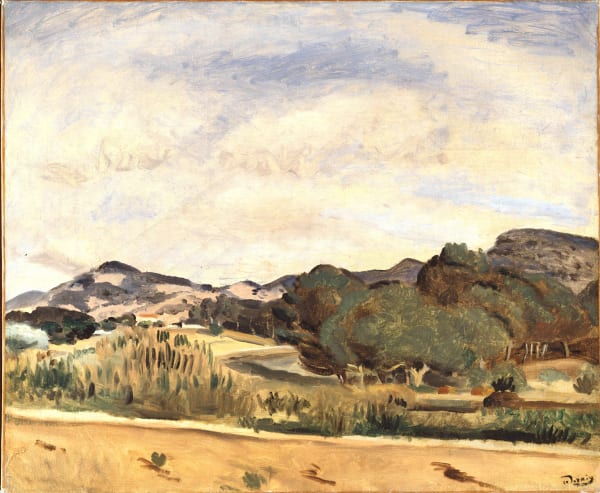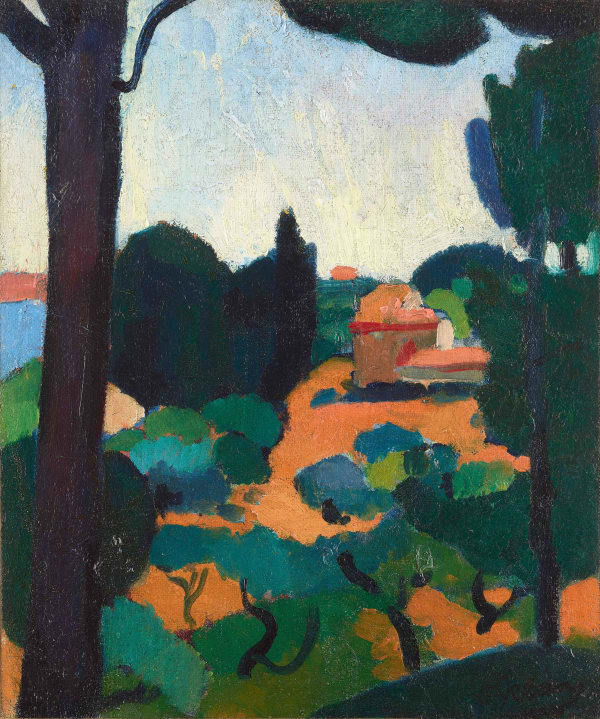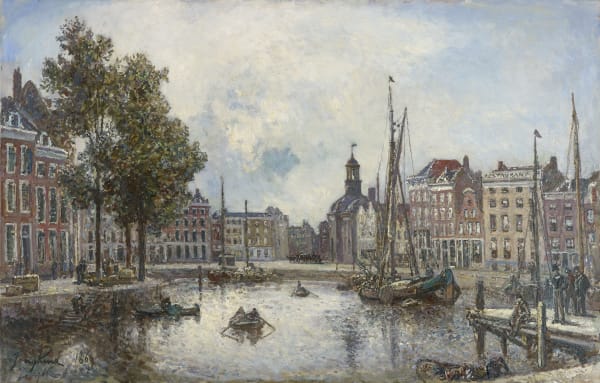André Derain French, 1880-1954
As a painter, sculptor and printmaker, André Derain was a major influence in the development of modern art. He is perceived to be one of the founding members of the Fauvist movement, which was characterised by the use of strident, alluring, expressive colours and dynamic brushwork.
Derain studied painting in Paris at the Académie Carriere from 1898 to 1899. After meeting fellow student Henri Matisse and Maurice de Vlaminck in 1900, the three artists experimented with unrestrained brushwork and new composition arrangements, in a conscious and emotional approach to emphasise the expressive character of colour. Having been influenced by Vincent Van Gogh and the Pointillist work of Georges Seurat, their experiments eventually evolved into the Fauvist movement, which lasted from 1904 to 1908. Employing spontaneous brushwork and large patches of earth-colours, this movement re-defined modern painting, founding a new doctrine from which the Cubists and Abstracts could derive and emerge. “Fauvism was our ordeal by fire – colours became charges of dynamite,” Derain had explained. “The great merit of this method was to free the picture from all imitative and conventional contract.”
In light of his gallerist’s (Ambroise Vollard) recommendation, Derain left for London, in 1906 and, following the example of artist Claude Monet, painted his view of the Thames.
The year 1908 marked a significant shift in Derain’s artistic career, moving away from Fauvism, he began research on neoclassical forms of painting. Stirred by Cezanne’s geometric work and the Old Masters, the artist synthesised a modern mode of rendering traditional genres and subject matter, in dialogue with the past.
Derain imbibed these other artistic styles, for instance primitive art, into his own work. The spiritual allusions of his later paintings, were taken from medieval and Quattrocento art, which had also been prevalant in Cézanne’s work. Since 1907, Derain had developed an interest in, and amateur collection of, African sculpture, which built upon the plastic values of his already eclectic, non-European aesthetic. Fundamentally, the artist’s work and particularly his sun-soaked landscapes were symptomatic of his erudite nature, which lent them a distinguishing philosophical depth, manifest via his experimental colour palette.
Throughout his career, Derain exercised a profound interest in the intertwining relationship between the individual’s emotional perception and artistic creation. We see this as a changing paradigm, interwoven through Derain’s persistent reflections on painting, regarding both style and subject. However, it was also manifest in the artist’s considerable body of sculpture, the sets and costumes he designed for four ballets and several fine book decorations he all created later in his career. His philosophical curiosity for art’s capacity to evoke emotion in the beholder, through modes of perception, remained a stimulating, significant influence for later modern and contemporary artists.
The artist’s work is included in numerous museums around the world such as Centre Pompidou, Paris; Museum of Modern Art New York; National Gallery, London; Musée d’Art Moderne, Paris; Hermitage Museum, Saint Petersburg.
-
 André DerainAssiette de peches, c.1938Oil on canvas20 x 39.8 cm
André DerainAssiette de peches, c.1938Oil on canvas20 x 39.8 cm
7 1/8 x 15 5/8 inches
Stamp with the signature lower right -
 André DerainNature morte, c. 1904Pen and black ink on paper38 x 32.1 cm
André DerainNature morte, c. 1904Pen and black ink on paper38 x 32.1 cm
15 x 12 5/8 inchesStamped lower right a.derain -
 André DerainVue de la Madrague, 1922Oil on canvas45.6 x 54.9 cm
André DerainVue de la Madrague, 1922Oil on canvas45.6 x 54.9 cm
18 x 21 5/8 inchesSigned lower right
-

TEFAF Maastricht
13 - 20 Mar 2025We are delighted to participate in TEFAF Maastricht 2025, where we are exhibiting a selection of 19th—and 20th-century French paintings and works on paper. Among the highlights is a curated...Read more -

BRAFA
23 Jan - 2 Feb 2025For BRAFA’s 70th Anniversary and our first participation in the fair, we are delighted to present a rare selection of 19th and 20th-century French works, showcasing the rich diversity and...Read more -

TEFAF Maastricht 2023
11 - 19 Mar 2023Join us at TEFAF Maastricht 2023, where we are exhibiting a selection of 19th and 20th-century French paintings and works on paper, including works by Eugène Boudin, Gustave Courbet, Charles-François...Read more -

André Derain, from Fauvism to Classicism
24 Jan - 21 Feb 2020For January 2020, Stoppenbach & Delestre is pleased to present a new exhibition entitled ‘From Fauvism to Classicism throughout the career of Modern French artist, André Derain’ – the first...Read more
-

Rhythm of lines and colours in French Avant-Garde
28 Jun - 26 Jul 2019Stoppenbach & Delestre is pleased to present 'Rhythm of lines and colours in French Avant-Garde', an exhibition including works by Charles-François Daubigny, Eugène Boudin, Armand Guillaumin, Hippolyte Petitjean, Louis Valtat,...Read more -

TEFAF Maastricht 2019
16 - 24 Mar 2019For TEFAF Maastricht 2019, Stoppenbach & Delestre is pleased to present a selection of 19th & 20th-century French artworks such as works by Louis Valtat, Henry Moret, Gustave Loiseau, Armand...Read more -

TEFAF New York Fall 2018 - Booth 321
25 - 31 Oct 2018Stoppenbach & Delestre is pleased to announce its participation in TEFAF New York Fall 2018. Featuring works by André Derain, Charles-François Daubigny, Maximilien Luce, Jean-Baptiste Camille Corot, Armand Guillaumin and...Read more











